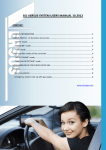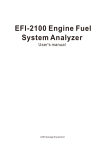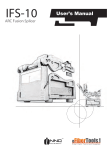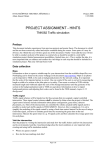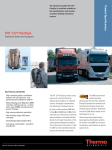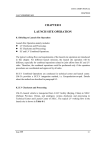Download USER`S MANUAL - Versus Gas USA
Transcript
GRATEC: ALTERNATIVE FUELS DIVISION USER’S MANUAL VERSUS GAS Premium Sequential Systems VERSUS GAS USA 1/1/2013 This manual describes all possible scenarios the user may face as well as the safe operation of the VERSUS system. Before using your new CNG/LPG fueled vehicle, please read and study this manual and its contents. If in any doubt, please ask the installation shop staff for a detailed explanation of the operation of your new VERSUS GAS system. [email protected] www.versusgasusa.com SGI VERSUS SYSTEM USERS MANUAL 10.2012 CONTENT: GENERAL INFORMATION ............................................................................................................ 3 VERSUS SWITCH - its functions and service ............................................................................... 4 “AUTO” mode ......................................................................................................................... 5 “GASOLINE” mode .................................................................................................................. 5 “GAS” mode ............................................................................................................................ 5 Other possible modes of the controller: .................................................................................... 7 “AUTO-TUNING” mode ........................................................................................................... 7 “GAS LEAK DETECTION” mode ............................................................................................... 7 SAFE HANDLING OF CAR FUELED WITH CNG/LPG ..................................................................... 8 OTHERS ....................................................................................................................................... 9 CNG/LPG consumption ........................................................................................................... 9 Emergency system start up with gas supply .......................................................................... 9 www.versusgasusa.com GENERAL INFORMATION The VERSUS GAS Sequential system is the best solution for the latest generation fuel injected vehicles. The VERSUS GAS name represents the most advanced level of development of the CNG/LPG conversion systems in the industry. The VERSUS System is fully automatic and maintenance-free. It immediately switches to gasoline when your CNG/LPG tank is empty. After refueling at least a half tank, it automatically switches to the CNG/LPG supply. In the event of a failure of any component or leakage of the system it automatically disconnects all the valves and switches to gasoline. Practically the only required element of VERSUS operating system is its regular service at an authorized workshop. All key elements of the VERSUS System meet the safety requirements of the regulations ECE110R00, ECE67R01 and NFPA 52. This manual almost entirely describes the possible scenarios the user may face and the safe operation of the VERSUS system. Before using your new CNG/LPG fueled vehicle, please read and study this manual and its contents. If in any doubt, please ask the installation shop staff for a detailed explanation of the operation of your new VERSUS GAS system. For more information about the SGI VERSUS GAS system components, please visit our website at www.versusgasusa.com. Bookmark: VERSUS GAS SYSTEM Gasoline supply Normally the vehicle engine is started with the original (OEM) fuel - gasoline. Switching to the CNG/LPG supply is carried out automatically after obtaining appropriate values, such as the right coolant temperature and engine RPM to ensure proper operation of the CNG/LPG-powered engine. Always avoid low amount of Gasoline l in the tank. The small state of fuel can damage the fuel pump, therefore driving on the so-called “reserve tank” is not recommended. Filling with CNG/ LPG CNG: In the United States of America, most public fill stations are unmanned and can be activated by the swipe of your credit card. The CNG filling nozzle will attach onto the vehicle much like an air hose coupler connect and disconnect. Your CNG tank will fill to roughly 83% capacity at a 3600 psi fast fill station. A nozzle connector that is blue represents a 3000 psi connection, while a yellow nozzle represents a 3600 psi connection. Your system is a 3600 psi station, although you could still use the 3000 psi connection if needed. There are many different connector styles; please observe others filling around you to see how your station works. When CNG is compressed the temperature of the CNG tank mounted in the vehicle may increase or decrease due to the physical properties of this process. It is a natural process and is completely safe from the point of view of the vehicle operation. LPG: Filling takes place through a gas valve, which limits the available capacity of the tank to 80%. Level indicators show the LPG tank full at 80% actually used the tank volume. Always observe safe refueling rules. Ask the station staff for more details. VERSUS SWITCH - its functions and service This switch allows a manual selection of the type of fuel: gasoline or CNG/LPG. It is also possible to activate other states of your VERSUS system, widely described in this chapter. The VERSUS system in normal operation is 100% maintenance-free, which means that the manual switching of the fuel is not required from the user of the system. VERSUS controller mode signaling Picture 1a: VERSUS switch – general view 1. VERSUS Switch “MODE” and other states of display 2. VERSUS change-over switch button There are three basic modes of operation: “AUTO” mode Picture 1b: “AUTO” mode display When in the "AUTO" mode, the switch shows all the LEDs blinking as shown in Picture 1b. Operating in this mode means that the gasoline is supplied, and engine is ready to switch to the alternative fuel supply after meeting the switching parameters (gas temperature, engine RPM, programmed switching time). The system being ready to switch once parameters are met is indicated by the flashing LEDs. Automatic switching to CNG/LPG supply After turning the key to the ignition position, the VERSUS system is activated – the VERSUS switch LEDs start blinking. When all LEDs are flashing the vehicle continues to be operated on gasoline. After fulfilling all the switching conditions, the system changes the fuel to the CNG/LPG supply (LEDs stop blinking, tank level is shown). If extended features of VERSUS buzzer system are enabled, this process can be further indicated with a beep signal. Ask your installation shop staff for more details. Manually switching to gas supply In order to switch from gasoline, when no LEDs are lit, to CNG/LPG simply press the switch. The LEDs will begin to flash - the engine is still powered with gasoline. After fulfilling all the conditions required to switch fuels, the system will be switched to CNG/LPG. (LEDs stop blinking – lights go solid and tank level is now shown). “GASOLINE” mode Picture 1c: “GASOLINE” mode display When “GASOLINE” mode is operating, all LEDs on the switch are off, as shown in Picture 1c. This means that the engine is powered by gasoline, regardless of the switching parameters. The change of the fuel type is possible only by pressing the switch. When pressed, the VERSUS system will switch to "AUTO" mode. During the operating conditions, in order to switch the engine from CNG/LPG (LED lit) to the gasoline supply, press the switch. The LEDs will then go off which means that the engine is gasoline powered. “CNG/ LPG” mode When you are driving on CNG/LPG it is indicated by one or more LEDs on the fuel switch being illuminated. The current level of CNG/LPG in the tank is displayed after switching the engine to the alternative fuel supply. This indication of the level of the CNG/LPG in the tank should be treated as an estimation of the amount of the CNG/LPG actually in the tank; this is due to the high inertia of the alternative fuel in the tank and the technical capabilities of the measurement system. The amount of gas in the tank Picture 1d: Tank full Tank full - light up of all the LEDs (Picture 1d) Picture 1e: 75% 3/4 of a tank (Picture 1e) Picture 1f: 50% 1/2 of a tank (Picture 1f) Picture 1g: 25% 1/4 of a tank (Picture 1g) Picture 1h: Reserve Reserve of CNG/LPG in the tank (flashing red LED - Picture 1h) Automatically switching to gasoline from the CNG/LPG supply During operation of the VERSUS system in CNG/LPG mode (LEDs lit) it is possible to automatically switch to gasoline. Automatically switching to gasoline occurs in two cases: Picture 1i: “EMPTY” Tank mode display a) Lack of CNG/LPG in the tank. The VERSUS system will automatically switch to gasoline due to the lack of CNG/LPG in the tank. This is indicated by flashing LEDs one after the other (Picture 1i), and also by a beep signal. In this mode, the engine is being powered with gasoline. b) Error or system failure. In case there is a failure to launch "AUTO" mode from the switch, please contact your local VERSUS GAS installation shop. The system automatically closes the CNG/LPG valves and will return directly to running on gasoline (no LEDs highlighted). In addition, this process will be indicated with a beep signal. Other possible modes of the controller: “AUTO-TUNING” mode Picture 1j: “AUTO-TUNING” mode display The latest model of the VERSUS control units are equipped with an automatic tuning system to ensure the driving parameters are optimal. The auto-tuning feature can be programmed by the installer and is indicated by the upper LED continuously flashing on the switch (Picture 1j). While in this mode the illumination of other LEDs are possible in addition to flashing top LED. NOTE: While in the auto-tuning mode, pressing the switch button to change fuels is not recommended. In this case, the automatic tuning may take, a longer than expected, 30-40 minute drive. Completion of the auto tuning feature is indicated by four beep signals. Then the controller will switch to "AUTO" mode. “GAS LEAK DETECTION” mode Picture 1k: “GAS LEAK DETECTION” mode display 1. The engine should be started and running on gasoline (“AUTO” mode with the diodes blinking or in “GASOLINE” mode with no diodes shining/blinking) 2. Press and hold the switch button for about 10sec. 3. After this time one beep signal can be heard and the switch will start to indicate the process of testing with two extreme diodes blinking (see Picture 1k). 4. Release the button and wait for test end. Scenarios: Picture no 1l: leakage test positive a) Test positive – no leakage: For the next 15 seconds a measurement of pressure is recorded and if there is no drop of the pressure (there is no a leak), the controller completes the procedure that is confirmed with: - Two top diodes shining for 3 seconds (Picture 1l) and - One beep signal can be heard After this time the controller switches to “AUTO” mode. Picture no 1m: leakage b) Test negative – leakage detected: If within 15 seconds, the controller registers a pressure decrease of more than 15kPa the controller will complete the procedure with: - Two bottom diodes shining for 3 seconds (Picture 1m) and - Triple beep signals can be heard After this time the controller will switch to “Gasoline” mode. test negative Notes: - In the event tank is empty, the leakage test will never be performed correctly; the result will be negative. Please make sure that the tank is at least ¼ filled. - Please note that this procedure can only check for leakage of the output section of the regulator; gas hose with filter, injection rail and Pressure sensor/Map-Sensor. Other leaks are not detected. - The efficiency of the procedure also depends strongly on the type of regulator (solenoid valve must be attached close to the regulator). If the solenoid valve is located far away from the regulator and there is a pipe full of CNG/LPG between the devices, the potential pressure fall of the evaporated CNG/LPG pressure will be compensated by the CNG/LPG coming from this intermediate pipe. In such a special case (solenoid valve far away from the regulator), medium and small leaks will not be detected. - It is unacceptable to check for leaks just by using the above procedure. The leak test must always include all pressure connections with the use of an appropriate leak tester. SAFE HANDLING OF A CAR FUELED WITH CNG/LPG Regular maintenance of the components of the VERSUS system and all other components of the vehicle is essential to ensure safe and efficient operation of the VERSUS system. Conducting periodic inspections of your system will extend the life and ensure proper operation of the system components. Maintenance service An inspection of the VERSUS system is recommended every 8,000-10,000 miles to help ensure the full efficiency of the system. The VERSUS system has the option to enable an indication of the needed inspection- this function can be enabled by the installer. Ask the installer for details. Regular maintenance inspections of the VERSUS system are not to replace the manufacturer's suggested maintenance of the vehicle, which should be carried out in accordance with the vehicle manufacturer's service guide. 1. Condition for safe operation of the vehicle with CNG/LPG installation is to control technical state and systematic inspections of the CNG/LPG components in an authorized VERSUS GAS installation shop. 2. Your vehicle, with the installed VERSUS system, should be mechanically tested at least once a year. This also applies to new vehicles. 3. The VERSUS control unit should be protected from direct exposure to water. It is unacceptable to wash (especially with high pressure) the engine compartment, because it can result in water damage to the component. Water damage is not covered under warranty. 4. In case of a suspected failure of any of the VERSUS system components, it is essential to go to an authorized VERSUS installation shop immediately for further diagnostics. In this case, the controller must be switched to run on gasoline (CNG/LPG solenoid valves closed). 5. Any service or repair work should only be performed by an authorized CNG/LPG installation shop. When refueling your vehicle, please be aware of all safety rules. Your system is a 3600 psi system (most advanced system). DO NOT fill up with any pressures above this working pressure. 6. The CNG/LPG tank should be properly secured and protected. It is prohibited to use CNG/LPG tanks or tubing that is dedicated for any other use than an installation in vehicles. All NFPA 52 guidelines must be followed in the installation process. 7. CNG is lighter than air and will rapidly rise if a leak was to occur. LPG on the other hand is heavier than air, which means that in the event of a leak, the gas builds up in the lower part of the room / surroundings. Therefore, the garage must have an efficient ventilation system. 8. If the vehicle was involved in a collision, it should be subject to an inspection by an authorized installer of CNG/LPG VERSUS systems before re-use. 9. It is forbidden to: a) Make unauthorized repairs or adjustments to the CNG/LPG system b) Overfill the tank above the legal limit. Depending on the country and type of gas they are: LPG: 80% tank’s water capacity CNG: 3600 psi or max operating pressure of the CNG components. Ask the installer for more details c) Use the VERSUS system after finding leaks d) search for leaks with a flame 10. Due to the technical parameters of the individual components, use only original spare parts of the VERSUS system. In particular, it refers to the operational components such as filters, reducer repair kits and injection rails, system sensors and other strategic items. OTHERS CNG/LPG consumption Due to the technical properties of CNG/LPG, it is possible and permissible the amount of gas combustion will increase by 10-20% compared to the amount of gasoline burned. This process, with the participation of the VERSUS controller, is primarily controlled by the gasoline control unit and original gasoline vehicle sensors. Emergency system start up with the CNG/LPG supply In case the vehicle cannot run on gasoline (e.g. due to fuel pump failure), it is possible to emergency start the vehicle on CNG/LPG. To do this: a) Press and hold the button on the VERSUS switch b) Turn the key to the “on” position, press and hold the switch button, start the engine while holding the switch button. c) Release the button once vehicle is started. NOTE: Please note that this is only to be used in an emergency situation. Multiple engine starts running in emergency mode can cause damage to the catalytic converter and other engine components. Emergency start is only possible when air temperatures are warm and your VERSUS system has been properly installed. This mode should be considered as a necessity. When engine started with gas supply, it is necessary to warm up the engine before driving on idle. In case there are any hesitations on how to use your VERSUS system – you can always ask the installation shop staff for more details. The pictures, text description, nameplates, technical data that is contained in this manual are the property of FHT VERSUSGAS. Copying of this property without FHT VERSUSGAS prior written permission is prohibited










